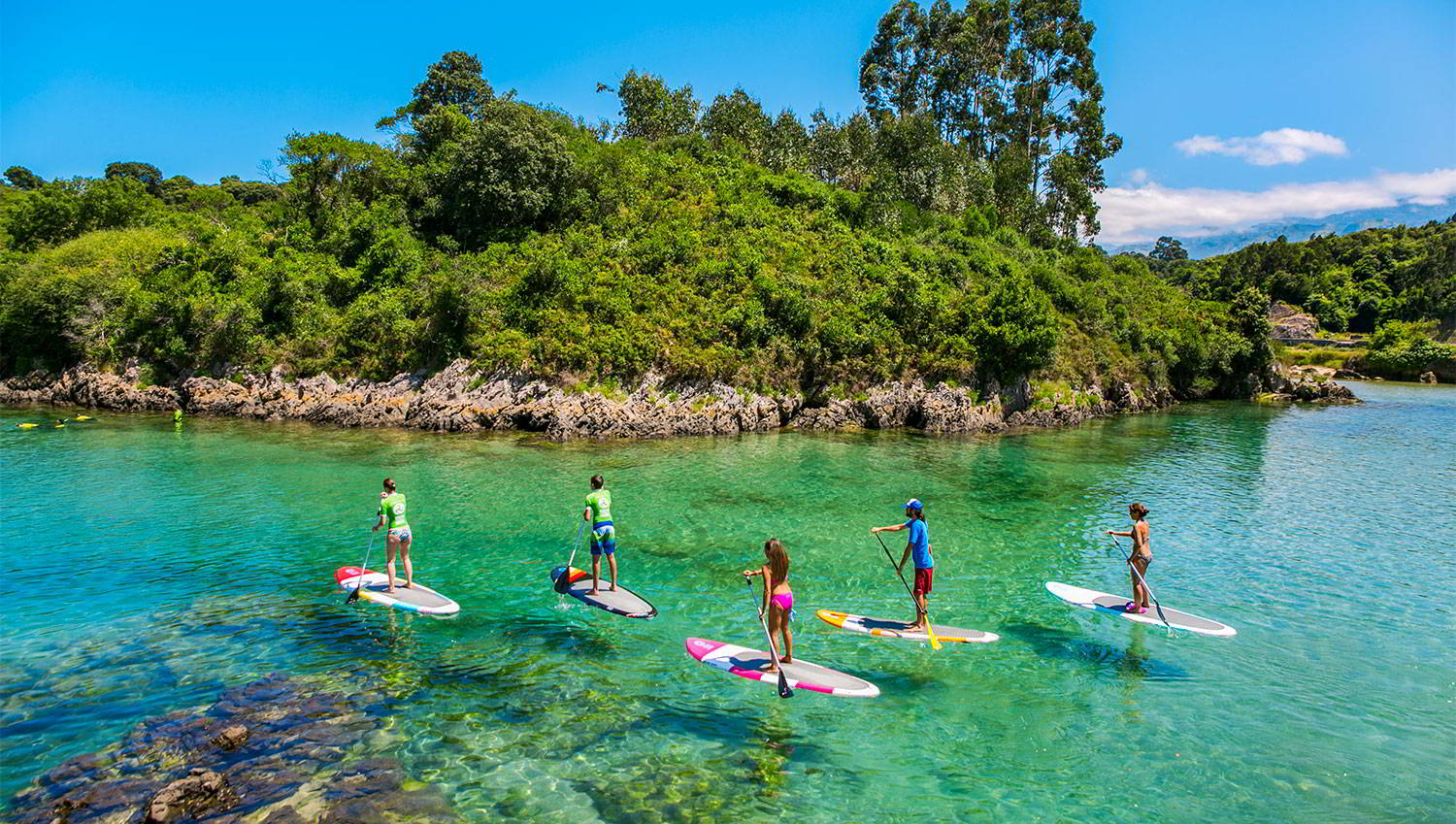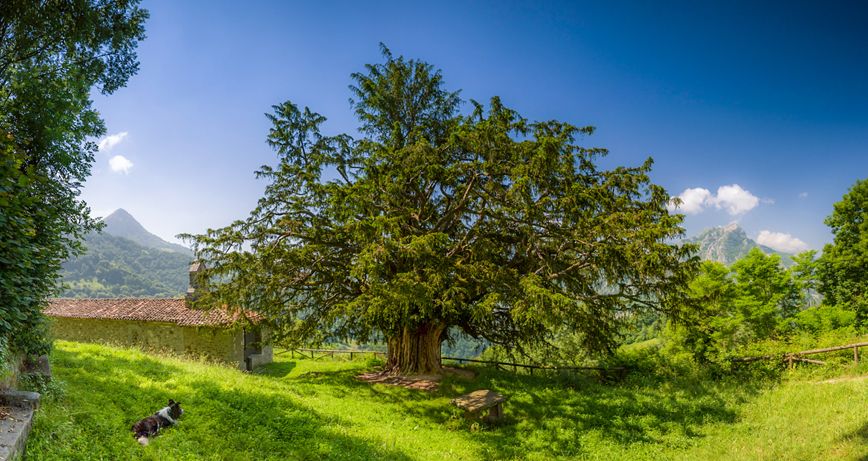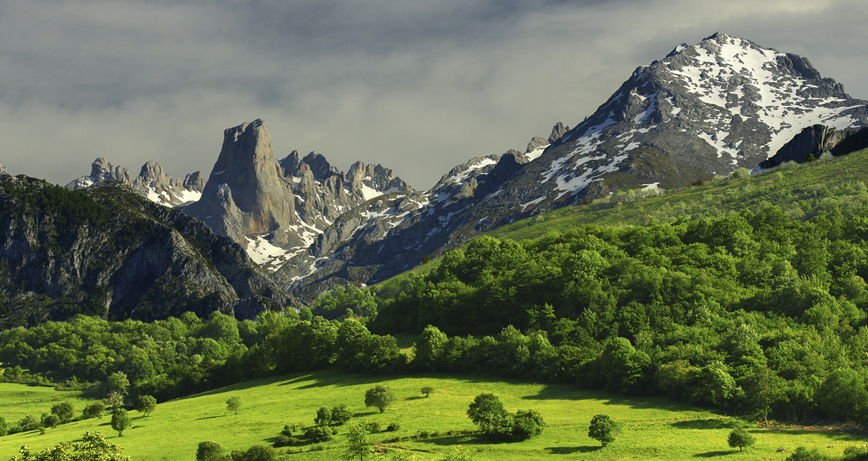Back Top 10 things to see and do in and around Ribadesella
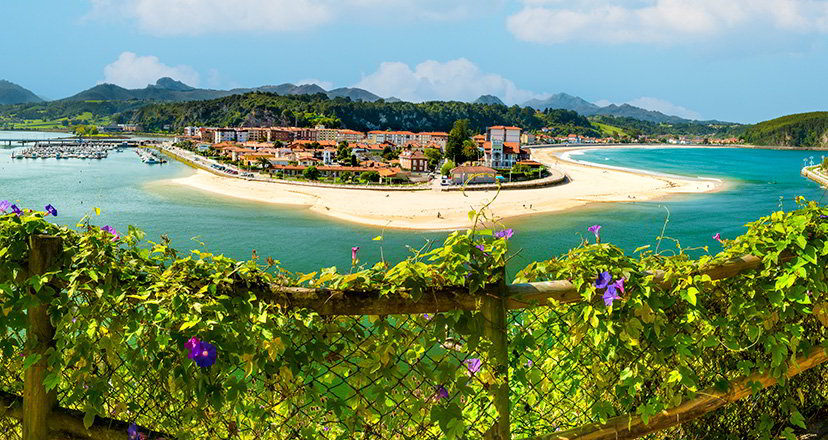
Top 10 things to see and do in and around Ribadesella
Ribadesella and its council is one of those places with charm, where you can enjoy the coast and the mountains, and an infinite number of attractions.
Prehistoric, seafaring, Indian. Friendly, warm, pleasant, a lover of art and socialising, walking, sport and nature. An emblem of good food. This is the historic town of Ribadesella/Ribeseya. Located on the coast of eastern Asturias, it is one of the gateways to the Picos de Europa.
Ribadesella has an eternal promenade, because at every turn you discover something new, different and comforting. And what's more, its rural, natural surroundings are indescribably beautiful. So Ribadesella and its council is one of those places with charm that will be unforgettable.
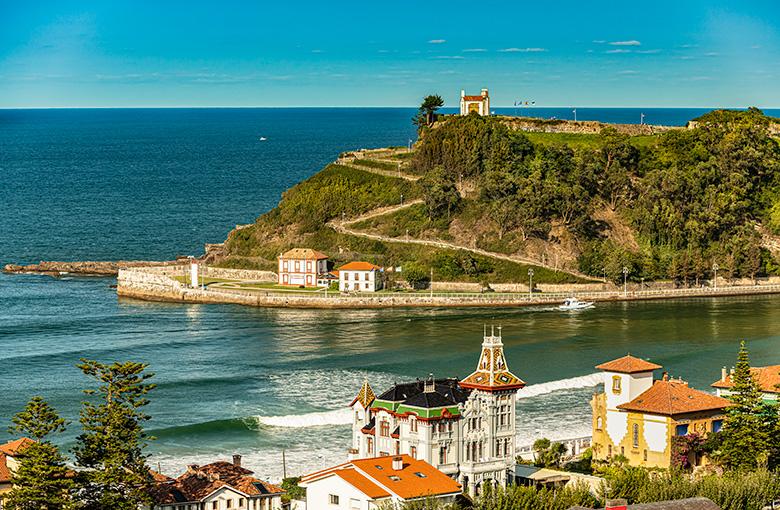
The "heart" of the town of Riosella offers a wide variety of attractions, ranging from an interesting historic quarter, a colourful Paseo del muelle (promenade) named after a princess, a Paseo de la grúa (crane promenade ) decorated with panels by Antonio Mingote, or the emblematic Guía hermitage, perched on the highest point of the promontory above the mouth of the port... And all this without forgetting its beaches, its Paseo de los Vencedores del Sella, its spectacular Indian architecture on the seafront, and one of the most important prehistoric caves in the world, Tito Bustillo, declared a World Heritage Site by UNESCO.
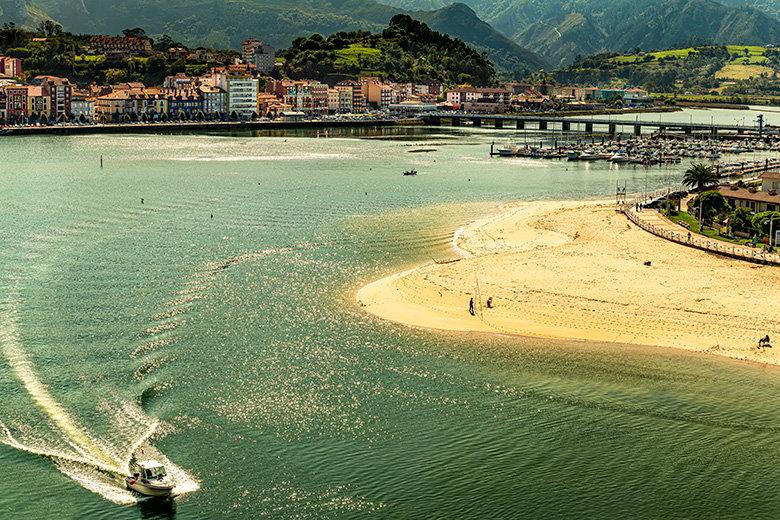
But also, in a few steps the town takes you to incredible places such as the village of Tereñes, with its lighthouse and its Jurassic cliffs, to the immense Vega sandy area, to villages such as Ardines, Cueves, Sardalla, Sebreñu, El Carmen/El Carme, to cliffs and beaches such as Guadamía, and all along beautiful roads, or coastal paths and tracks.
And of course, Ribadesella as a whole is Jacobean. The Way of St. James of the Coast passes through the very centre of the town, and also through some of its most famous villages and beaches.
Ribadesella, town and villages, coast and mountains. It has it all in just a few kilometres and in an ideal setting for walking, or for getting around by bicycle, horseback, car... However you like and however you find it most pleasant.
So get ready, because here we begin a most entertaining itinerary!
A beautiful Old Town
Getting lost in the historic quarter of Ribadesella/Ribeseya is an experience in itself. Nowadays it is a restored and pedestrianised area, which is very easy to visit. You will come across authentic architectural gems such as the Casa de los Ardines, the Palacio de Prieto Cutre (now the Town Hall) and the Casona del Escudo.
You will walk through a medieval layout, where you will see cantilevered balconies, glazed galleries, attics in the form of attics, or façades with noble coats of arms and arcades, and where some buildings date from the 16th, 17th, 18th and 19th centuries.
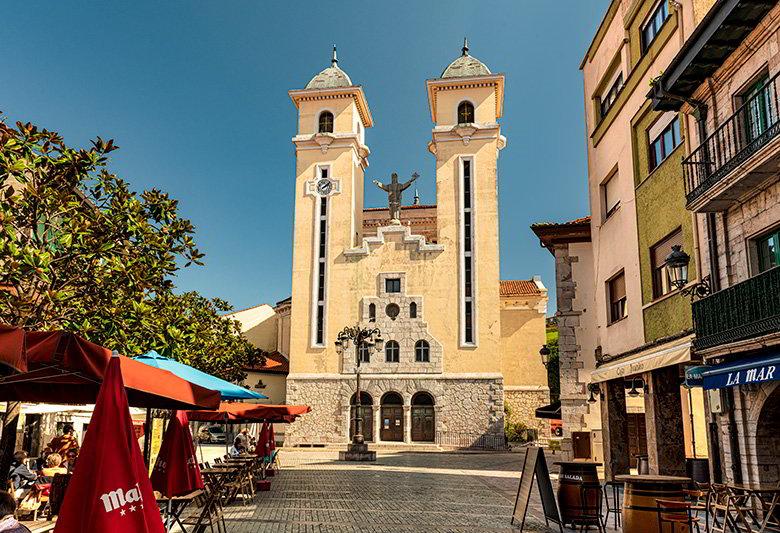
One of the best known places in this historic quarter is the square of the parish church of Santa María Magdalena, whose interior is worth a stop for the pictorial jewels that the temple treasures. The four murals painted in fresco by the brothers Bernardo, Celestino and Antonio Uría Aza, located on the four sides of the transept, are a clear allegory against the wars. Furthermore, the Uría Aza brothers represent that Ribadesella of artists and intellectuals, which has contributed so much wealth to the spirit and physiognomy of this illustrious town and its council.
On the other hand, the historic centre of Ribadesella is the setting for one of the oldest weekly markets in Asturias, as its origins date back to the 13th century, and it was born almost at the same time as the town itself. Every Wednesday the traders and small producers of the region offer the public vegetables, seasonal fruit, "fabes", chestnuts, hazelnuts and walnuts, cheeses, apple sweets, "pantrucos" or corn flour, the latter being essential for the fried tortos and for the consistent "borona", baked and stuffed with sausages. A sample of the gastronomic and cultural richness of eastern Asturias.
A short walk through the old quarter will reveal the greatness of Ribadesella/Ribeseya!
The beach of La Atalaya, the traditional "solarium" of the people of Riosella
Without leaving the historic centre, you will find La Atalaya Park, and very close to the beach of the same name. This is one of the many and varied bathing and sunbathing areas in the town, and has traditionally been the "solarium" of the locals. Hidden, cosy and sheltered, this rocky area extends into stone coves and privileged bathing areas, with natural pools that will make you enjoy the purest of the Bay of Biscay.
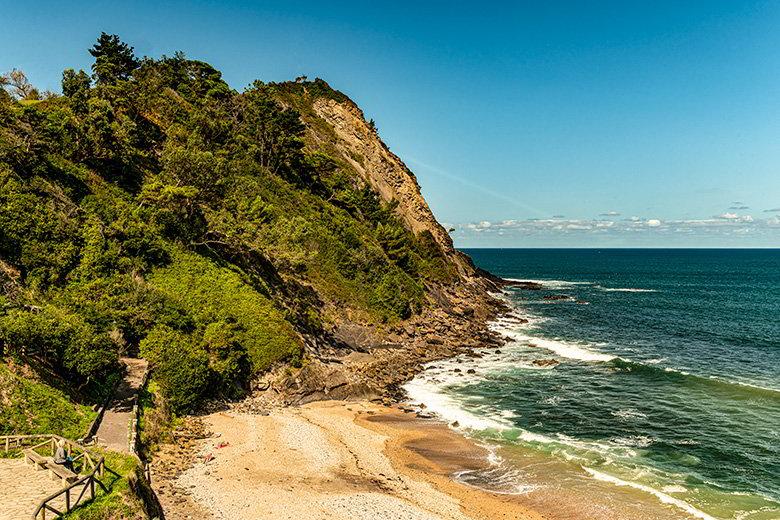
As you walk up from the park towards the beach, you will see on the left hand side a spectacular Quinta Indiana, also called La Atalaya, which adds a touch of exotic colour to this part of the village and is a remarkable prelude to what you will find on the other side of the estuary...
La Atalaya beach will be one of your unexpected discoveries!
And with the particularity that you have a path that connects it with the beach of Guadamía!
The village of the three promenades
After a stroll through the old town, it is time to look out over the estuary and enjoy the flowing river Sella as it meanders towards the sea. Here you begin to savour the seafaring, sporting, fishing Ribadesella/Ribeseya... the Ribadesella/Ribeseya that smells of saltpetre, and which is savoured in stews and recipes that sail between the river, the sea and the mountains...
The Paseo del Muelle, called Princesa Letizia - because the current Queen of Spain used to spend her summers in the town -, reveals seafaring scenes at every turn: moored fishing boats, sailing boats from other seas, the rula, the anglers, and always in the estuary, the canoeists and canoeists training, and on the other side, the charming Ribadesella marina.
Ribadesella/Ribeseya is one of the international capitals of canoeing, and for 90 years it has been the finishing line of the International Descent of the Sella, one of the oldest canoeing events in the world. In fact, the Fiesta de las Piraguas is the only one declared of International Tourist Interest in Asturias.
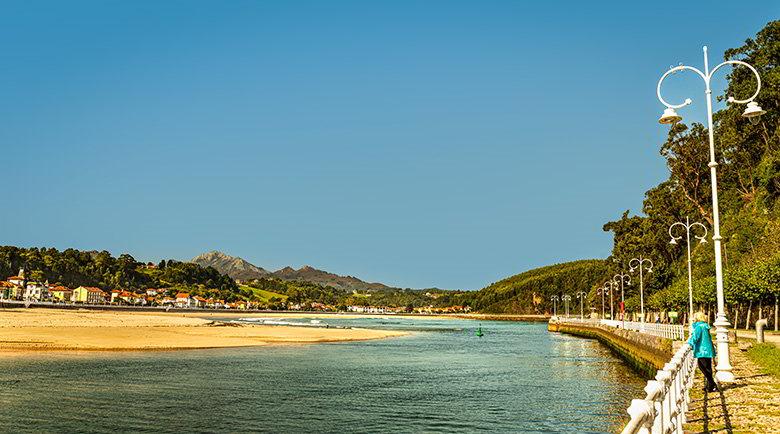
Another of its memorable walks is that of La Grúa, which gives an idea of the port and historical dimension of Ribadesella/Ribeseya, which centuries ago was a true port of the Indies, because from here brigantines set sail with hundreds of people who set out to sea in search of a better fortune... This walk has seen farewells and melancholy farewells. Today there is still an air of all that, with its lantern and its Fonte del Cay, and with its views of the sea and the cliffs, and an old cetárea, today transformed into a spontaneous natural swimming pool.
The Paseo de la Grúa, with its panels by Mingote, six in total, where the brilliant cartoonist and humorist gives an original synopsis of the history of Ribadesella/Ribeseya, is one of the landmarks of the town. Walkers, pilgrims, tourists, fishermen. Some on foot and others by bike. Some with their pets and others without them, but all enjoying this work of art in the open air, and seduced by the charm of this promenade, which leads to the hermitage of Guía.
And the third emblematic promenade in Ribadesella is the Paseo de los Vencedores del Sella. It is a sort of Hollywood-style walk of fame, but for canoeists who have won the International Descent of the Sella, a festival and sporting event that puts Ribadesella on the world map of leisure and sport every year. Located on the banks of the estuary, very close to the finish line of this event, that is, next to the bridge that crosses to the other side of the town, it is a place that is well worth a visit, especially for lovers of this river sport.
So Ribadesella/Ribeseya is the town of the three walks!
The Guía Chapel, a symbol of Ribadesella
The Guía hermitage is undoubtedly one of the most admired and recognised symbols of the village of Riosella. You can reach it either along the Paseo de la Grúa, where you will take a stepped path almost at the end of it, or along another path that you will take very close to the Parque de la Atalaya, at the end of the Paseo del Muelle. Both options are very scenic and panoramic.
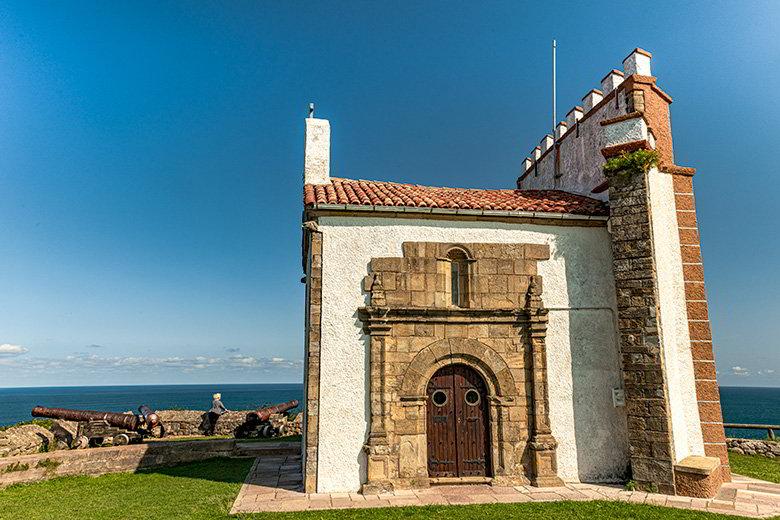
When you reach the top, you will be on Monte Corberu, a promontory with splendid views where this hermitage stands, dating from the 16th century, and which has suffered numerous vicissitudes throughout its history. The hermitage houses the Virgin of the same name, patron saint of the local sailors since time immemorial.
From this hill you will get a very precise visual "cartography" of the town and its surroundings: the beach of Santa Marina, the estuary, and the mountains near the town of Ribadesella/Ribeseya, with the peak of Mofrechu as the highest point. And just on the other side of the beach, the Somos mountain, so that between the Corberu and Somos, Santa Marina is a kind of perfectly shaped shell.
In the vicinity of the hermitage, you will find some canyons, which make a picturesque combination with the surroundings. They are authentic and point to the horizon, as if they wanted to protect the coast from pirates or foreign invaders...
And of course the views are breathtaking and unforgettable!
Santa Marina beach, pure "Cantabrian glamour".
On the other side of the estuary, after crossing the bridge, you will come to Santa Marina beach. Its promenade - the only one of its kind among the fishing villages -, which overlooks impressive palaces and Indian houses, has its origins in 1907, when the legendary Marquise of Argüelles set up a unique residential development. So the luxurious residences and hotels that exist today in this part of Ribadesella are a legacy of the constructions of the aristocrats and Indianos of that time.
This is how a different kind of seaside resort came into being, where the wealthier social classes bathed in the sun and the sea, in a perfect and peaceful place for long summer stays. This circumstance was the germ of the tourist and holiday Ribadesella/Ribeseya.
Obviously, you cannot miss a stroll along the beach of Santa Marina. It is a real marvel. You have to start at the so-called Punta del Arenal, where the Sella estuary makes its last bend before flowing into the Cantabrian Sea, and reach the so-called Punta el Pozu, at the westernmost end of the beach, where you will find dinosaur footprints.
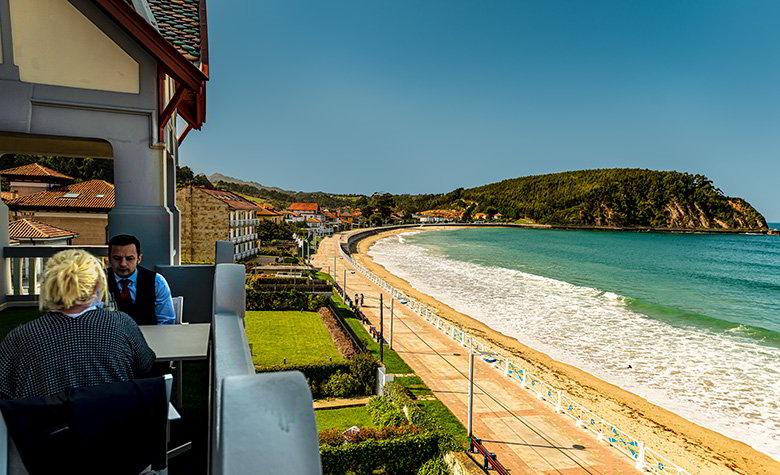
Along the way, palaces and emblematic houses, true architectural and historical jewels, some of which are nowadays converted into charming and warm hotels.
Of course, Santa Marina beach is ideal for swimming and surfing, a real sporting spectacle all year round on this sandy beach.
So, if you want to experience Cantabrian "glamour" in situ, Santa Marina beach is a perfect example!
Tito Bustillo, an icon of prehistory in the world
But the west bank of the river Sella has many more surprises in store for you, and one of them is a big one. Because when you cross the Ribadesella/Ribeseya bridge and go to your left, as well as having a different view of the town, with the prau de San Juan like a green island in the middle of the estuary, in just a few metres you come across one of the great temples of cave art at international level: the Tito Bustillo Cave, declared a World Heritage Site by UNESCO in 2008.
Discovered just over half a century ago by a group of Asturian speleologists, Tito Bustillo, with its paintings, engravings and other researched materials, is a prehistoric reference point of the first order. Next to it, the Cuevona is another cave of great geological wealth and extraordinary beauty. And the whole complex is located in the heart of the Ardines massif, one of the beautiful mountains that surround the village of Riosella.
This splendid natural setting is completed by the Tito Bustillo Cave Art Centre, where you can find out all the information available about the cave and enjoy all kinds of activities related to prehistory, many of them designed for the little ones at home.
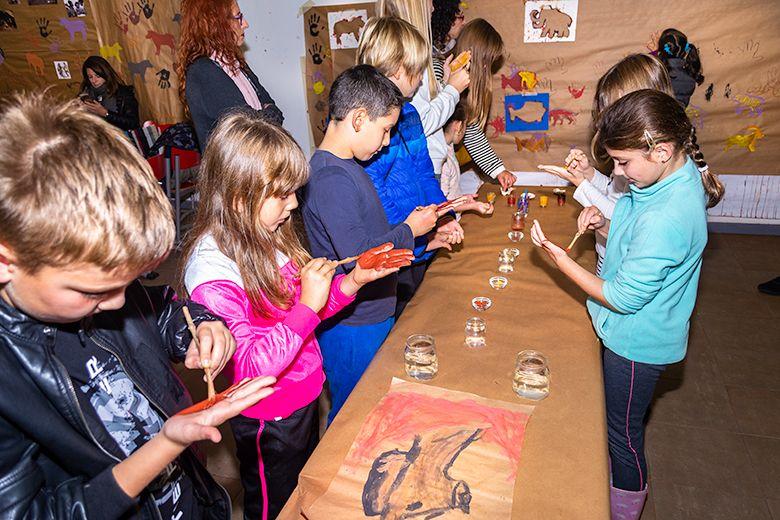
Both the Tito Bustillo Cave - with a limited daily capacity - and the Ardines Cave, and of course the Art Centre can be visited, although it is always advisable to check dates and times in advance.
You will be captivated by this great icon of prehistory in the world!
Ardines and its recreational area La Moría
After the stop at Tito Bustillo and its Cave Art Centre, you continue on your way and begin to enter the more rural Ribadesella.
A highly recommended visit is to go up to the village of Ardines, perched on a hill, with a recreational area ideal for a stroll, or to enjoy a leisurely picnic lunch. The views of the town of Ribadesella/Ribeseya are simply spectacular.
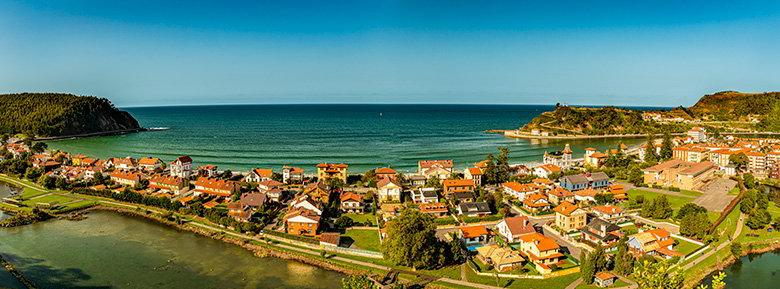
The hermitage of Guía, the mouth of the Sella, the beach of Santa Marina, Monte Somos, or the extensive natural park of the Malecón, the elongated (and little known) marshland that delimits the beach promenade to the south. The Malecón is of great ecological value, being a place of passage for migratory birds, and has an asphalted road and several footbridges and turrets, to comfortably observe its fauna and flora.
You will see that looking out from the recreational area of La Moría will reveal even more of Ribadesella/Ribeseya's secrets!
A world of fairytale villages
Rural Ribadesella is a world of fairytale villages. Hidden, quiet, with delightful landscapes, with dream views, with traditional houses, with granaries and bread baskets, with palaces, with Indian houses, facing the mountains or the sea, or both at the same time, with the flow of the Sella in its surroundings, with the buffoons as neighbours, with the cliffs as a backdrop, with the beach right next door... A peaceful world of infinite beauty.
Tereñes is one of those villages that you cannot miss. With its lighthouse illuminating sailors, and with its cliffs full of dinosaur footprints, which will take you back millions of years in a single glance. And from Tereñes it is very easy to go down to the village in a pleasant walk, or if you prefer to go west, you can reach the beach of Vega.
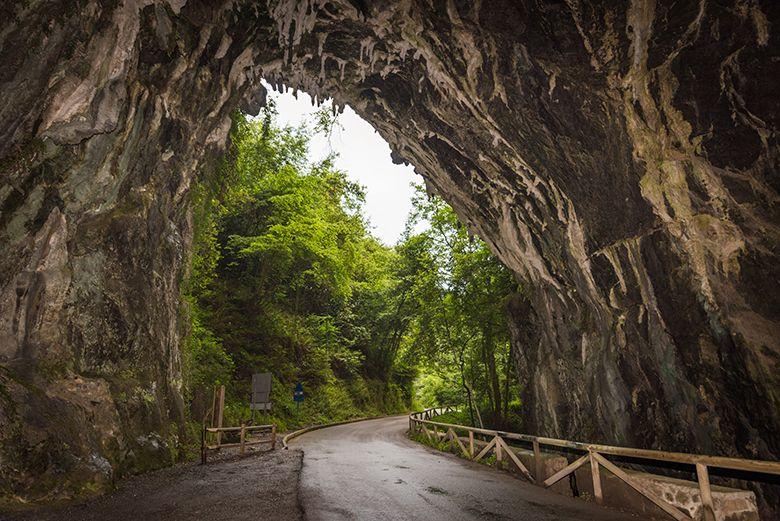
Or Cueves, as ideal as it is surprising, because you have to reach it through a natural grotto of impressive dimensions and shapes. And once there, its hórreos, its typical houses, its hydrangea bushes, its small church, its bar-shop...
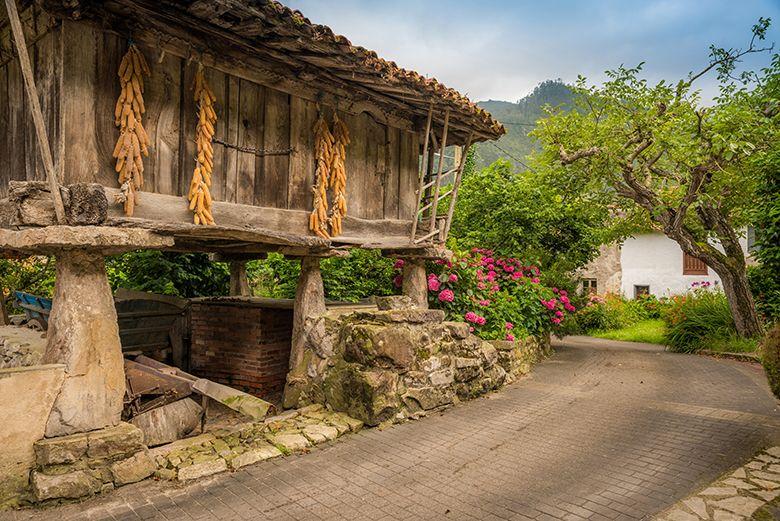
O Sebreñu, with its palace and its chapel, and its prodigious views of the mountains...
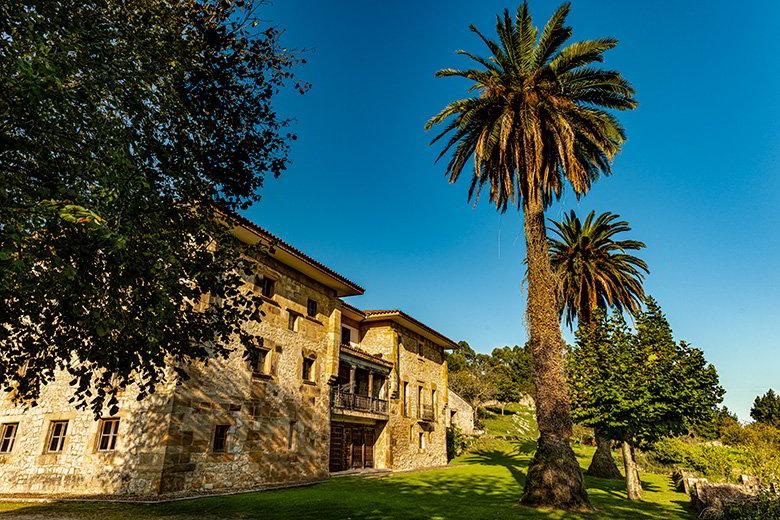
Sardalla, El Carmen/El Carme, Tezangos, Camangu, Meluerda, Collera or Cuerres, are some of the beautiful villages of the almost endless list that make up rural Ribadesella.
So you can make a nice and varied tour through the villages of Ribadesella!
Jacobean Ribadesella
The Northern or Coastal Way of St. James passes through Ribadesella, which is Jacobean no matter where you look, both the town and the surrounding area.
There are many interesting places and scenes along the Way as it passes through Ribadesella: Cuerres, the town of Ribadesella, San Esteban de Leces, Vega Beach and Berbes.

Villages, coast and beach, medieval towers, churches and chapels, and a beautiful and surprising town. All this and much more will be the legacy and the memory you will treasure of your Jacobean journey through Ribadesella.
Don't miss the Camino del Norte in this area, it's a real marvel!
The coast of beauty
Ribadesella could be called the coast of beauty. Because of its surprising shapes and landscapes, and because of their variety.
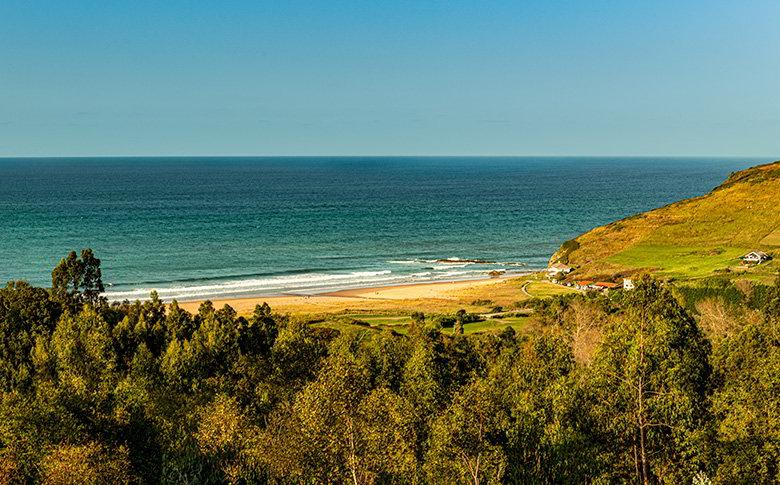
On the coastline of Riosella, you will find large sandy beaches, such as Vega beach, one of the largest in Asturias. Vega, with its dunes, its curious geology, its ideal wave for surfing, its atmosphere of beach bars and restaurants, its cosmopolitan air and the beautiful village that gives it its name, has everything to enjoy.
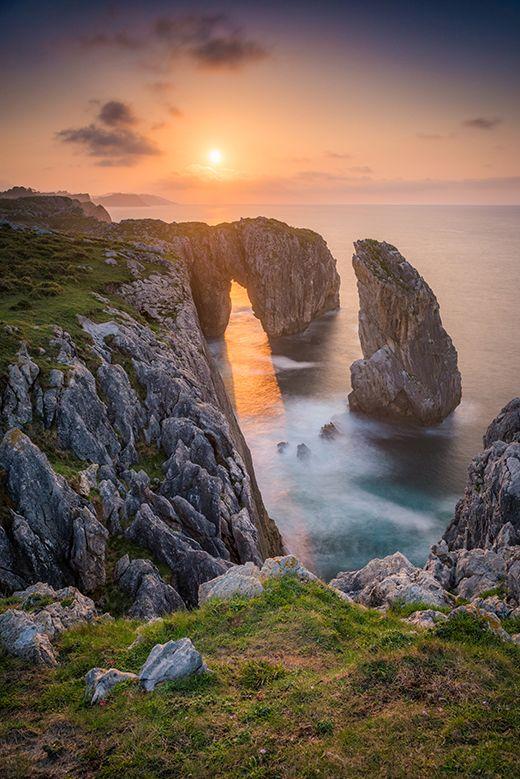
But this coast also delights you with cliffs that are works of art, as if you were in a large open-air sculpture park, where the sculptor has been the tides, the wind and time.
The cliffs of El Infierno are truly impressive for their shapes, and you can reach them through the village of Cuerres, and there is also a recreational area in the area.
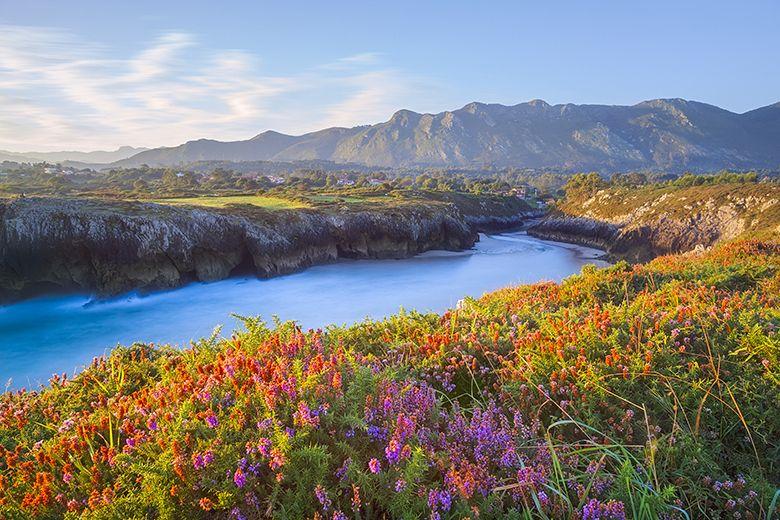
And to end your journey along the coast of Riosella, you must visit Guadamía, a beach of incredible beauty, which borders the neighbouring council of Llanes. From the Guadamía recreational area, you can contemplate the majesty of the cliffs and the originality of this beach, which is a kind of natural karst channel, where the river landscape merges with the seascape.
The coast of beauty will leave you speechless!
A tour of Ribadesella and its council will be a most rewarding experience! And if you liked this post, share it on your Facebook!
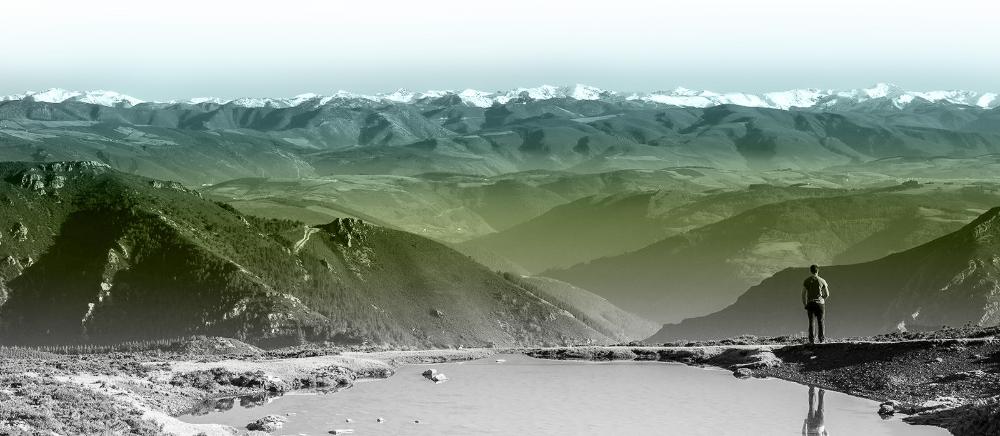
Subscribe to our newsletter and take advantage of offers, discounts, and news
Subscribe

